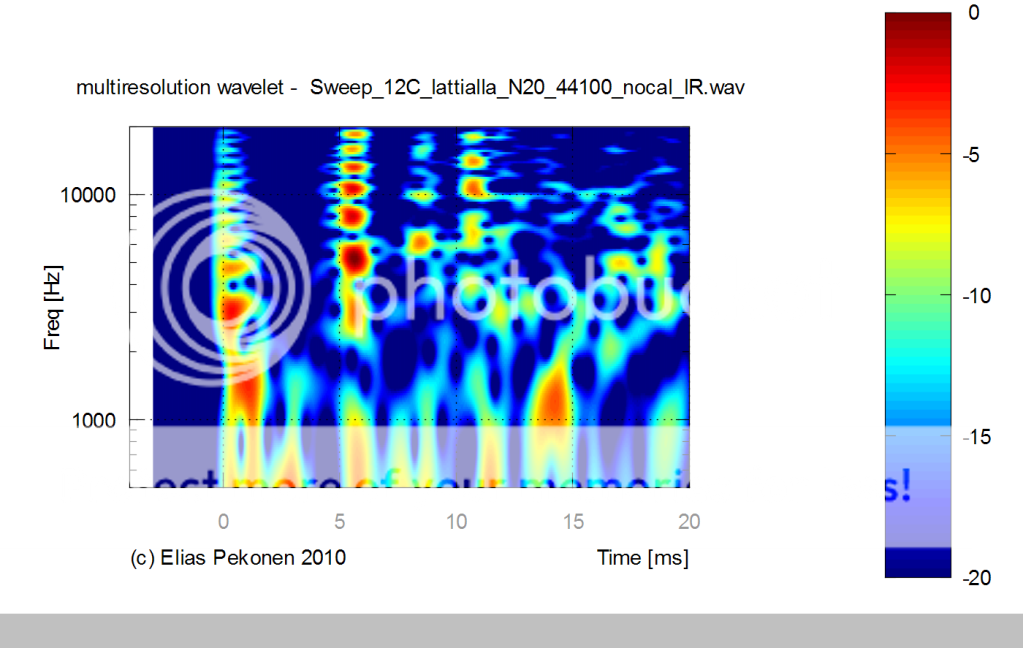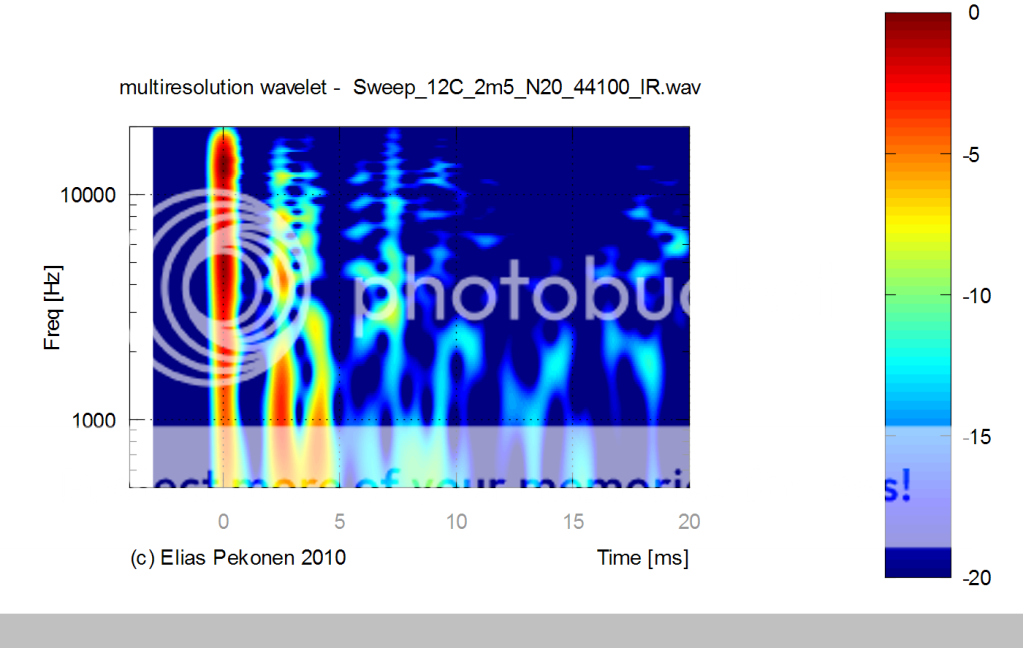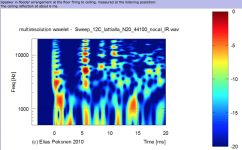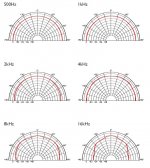You show/supply the measured data and I am sure the members here will argue with you about the theoretical interpretation.
exactly, pointless
Originally posted by weltersys:
Interesting that the flooder increased reverberation time as far out in time as 20 ms at only -6 to -10 dB, beyond the integration time for "single event" perception. The reverberation at -10 dB would sound half as loud as the original signal.
No doubt that would increase "spaciousness" and reduce detail.
Also of note, the first (ceiling) reflection of your speaker was stronger than the direct sound at high frequencies due to the narrowing HF pattern.
Back in the 1930's when long low frequency horns were first used with short high frequency horns it was found that the horn path difference of around 12 feet (10.6 ms) delayed the midrange response such that monitoring tests of a tap dance routine resulted in two taps being heard for every one recorded.
At high frequencies, 15-20 ms of delay is easily long enough to be heard as a distinct echo, rather than an integrated single sound, at lower frequencies the integration time becomes progressively longer.
Perception of echo vs. reverberation at typical speech and musical fundamental notes varies from around 25-50ms.
Elias' flooder delay chart shows HF energy delayed enough so that it would clearly be heard as an echo, and the 6 and 12ms delay clearly show that the speaker's HF dispersion is narrow above 3000 Hz, as the reflections are louder than the initial sound.
If Elias' speaker's dispersion was as wide as the FCUFS you and I use, the initial HF sound would be louder than the reflected delayed sound.
Since direct sound drops at 6 dB per doubling of distance, the longer path length reflected sound would be attenuated if a wide HF dispersion speaker was used, ergo the dispersion of Elias' speaker is revealed in the wavelet sweep.
These facts all simply agree with Elias' perception that "the flooder presentation was surely no-pinpoint.. and overall spaciousness was somehow increased over normal stereo triangle."
The trade of detail for spaciousness is an interesting choice.
Art
Interesting that the flooder increased reverberation time as far out in time as 20 ms at only -6 to -10 dB, beyond the integration time for "single event" perception. The reverberation at -10 dB would sound half as loud as the original signal.
No doubt that would increase "spaciousness" and reduce detail.
Also of note, the first (ceiling) reflection of your speaker was stronger than the direct sound at high frequencies due to the narrowing HF pattern.
The "psychoacoustic mechanism" of integration time has been understood since the early days of reproduced sound and movies.why no doubt "reduce detail"? What´s the psychoacoustic mechanism?
Are You sure? Do You know the radiation pattern of Elias´ test FCUFS?
Back in the 1930's when long low frequency horns were first used with short high frequency horns it was found that the horn path difference of around 12 feet (10.6 ms) delayed the midrange response such that monitoring tests of a tap dance routine resulted in two taps being heard for every one recorded.
At high frequencies, 15-20 ms of delay is easily long enough to be heard as a distinct echo, rather than an integrated single sound, at lower frequencies the integration time becomes progressively longer.
Perception of echo vs. reverberation at typical speech and musical fundamental notes varies from around 25-50ms.
Elias' flooder delay chart shows HF energy delayed enough so that it would clearly be heard as an echo, and the 6 and 12ms delay clearly show that the speaker's HF dispersion is narrow above 3000 Hz, as the reflections are louder than the initial sound.
If Elias' speaker's dispersion was as wide as the FCUFS you and I use, the initial HF sound would be louder than the reflected delayed sound.
Since direct sound drops at 6 dB per doubling of distance, the longer path length reflected sound would be attenuated if a wide HF dispersion speaker was used, ergo the dispersion of Elias' speaker is revealed in the wavelet sweep.
These facts all simply agree with Elias' perception that "the flooder presentation was surely no-pinpoint.. and overall spaciousness was somehow increased over normal stereo triangle."
The trade of detail for spaciousness is an interesting choice.
Art
Attachments
If Elias' speaker's dispersion was as wide as the FCUFS you and I use, the initial HF sound would be louder than the reflected delayed sound.
What speaker would that be? How is it set up? Could you post a IR of it at the listening position?
Originally Posted by weltersys
If Elias' speaker's dispersion was as wide as the FCUFS you and I use, the initial HF sound would be louder than the reflected delayed sound.
The dispersion of the FCUFS would definitely change the "spacious" effect, a wide HF dispersion speaker reveals it's floor location, a narrow HF dispersion has a source image varying from floor to ceiling with frequency.
Any "advantages" one may find in a FCUFS depend on far more details than the usual L/R ear level triangle placement.
Art
If Elias' speaker's dispersion was as wide as the FCUFS you and I use, the initial HF sound would be louder than the reflected delayed sound.
I used a Grundig YB 400PE in varying positions around a room, Graaf uses a wide dispersion co-ax (I forgot which) and I don't have the equipment to produce the nifty wavelet sweep which revealed Elias' FCUFS speaker's narrowing and disjointed HF response.What speaker would that be? How is it set up? Could you post a IR of it at the listening position?
The dispersion of the FCUFS would definitely change the "spacious" effect, a wide HF dispersion speaker reveals it's floor location, a narrow HF dispersion has a source image varying from floor to ceiling with frequency.
Any "advantages" one may find in a FCUFS depend on far more details than the usual L/R ear level triangle placement.
Art
Last edited:
I used a Grundig YB 400PE in varying positions around a room, Graaf uses a wide dispersion co-ax (I forgot which) and I don't have the equipment to produce the nifty wavelet sweep which revealed Elias' FCUFS speaker's narrowing and disjointed HF response.
What makes you think a Grundig YB 400PE and "a wide dispersion co-ax" (which you can't name) behave the same or any different than Elias' speaker?
The dispersion of the FCUFS would definitely change the "spacious" effect, a wide HF dispersion speaker reveals it's floor location, a narrow HF dispersion has a source image varying from floor to ceiling with frequency.
So what you're saying is that wide dispersion puts the perceived speaker location to the floor while narrow dispersion makes it vary from floor to ceiling? None of this sounds desirable to me.
..At high frequencies, 15-20 ms of delay is easily long enough to be heard as a distinct echo, rather than an integrated single sound, at lower frequencies the integration time becomes progressively longer.
Perception of echo vs. reverberation at typical speech and musical fundamental notes varies from around 25-50ms..
..These facts all simply agree with Elias' perception that "the flooder presentation was surely no-pinpoint.. and overall spaciousness was somehow increased over normal stereo triangle."
The trade of detail for spaciousness is an interesting choice.
Art
15-20ms delay of *direct* sound.. That's not what we are discussing here.
An actual echo requires both a fair bit of intensity (above direct sound) and time - along with reasonably discreet reflection point. +6db isn't going to generate an echo at less than 20msecs without a *very* discreet reflection for music reproduction.
Even under purposefully strained conditions - reflected sound will typically dominate direct sound and apparent source position will "move" to that dominate reflection (assuming the appropriate high freq. content is reproduced - with little lower freq. content). This usually requires a very large difference in intensity of low intensity direct sound to high intensity discreet sound, and the effect is aided if the the direct-sound's gradient is "broken" on its path to the listener.
At a somewhat lower time/distance (dependent on wavelength), the effect is more akin to "pulling" the image closer to the dominate points of first reflections. (..though the effect of that may be marginal.)
If you have two opposite points of dominate reflection the effect "stretches" the image, or a derivative of Acoustic's "apparent source width".
All 3 effects "moving" "pulling" and "stretching", are classical reasons for preferring sound absorption - particularly in the context of studios where panning accuracy is desired.
Because the measurements *appear* to correlate to Elias's subjective impression does not mean that they actually do correlate. There simply were not enough controls to come to any meaningful conclusion - other than to the example itself.
Additionally, coupling to the wall is likely to have an effect that *increases* the intensity of upper freq. reflections vs. direct sound, which is contrary to the FCUCS proposal. (..not that there won't be an increase at higher freq.s in a FCUCS, but just not that much of an increase in relation to its direct sound.)
As for the reduction in image "focus" and clarity:
I've personally heard radial speakers that were *at least* as "pin-point"/focus in their presentation as traditional monitors. (..clarity is a broader issue, it's not unreasonable to argue that reproduction that does not display venue effects as well is NOT as "clear" as one that does.)
For "focus" the real factors are the source-width vs. frequency + diffraction & near reflection elements vs. listener distance from that direct sound (..and specifically looking at the gradient of that sound expansion).
The same thing of course happens with natural acoustics. Move near a source and it becomes less "pin point". Move further away and it becomes more "pin-point" (..while also DECREASING direct to reflected ratio). Apparent source width at a distance decreases (both audibly and visually).
Last edited:
to illustrate my point let me quote from one of earlier posts in this thread:
it may be that You cannot understand what I am talking about because You have never heard anything like thatOne example of this is the beginning of the track Wish You Were Here, from Pink Floyd's album of the same name. At the beginning, the guitar is played through (or least made to sound like) a table radio, coming from just one speaker. With the Silent Speakers, this sounds like a real table radio sitting on top of the speaker, as if it was a small table. Then, when the lead guitar starts up (a superb recording of a guitar) it sounds remarkably natural both in tone and in size, floating in space is if the guitarist was standing right there between the speakers.
That song as for many is an old anthem of mine. I know exactly what you are talking about. As far as the old radio effect goes, a good approximation is high pass filter 200-300Hz, low pass filter about 2500Hz, and a liberal dose of hard limiting. Presto. The closing seconds of the song contain wind swept sound, that may in fact be the basic sound, however acquired, that may have been used to modulate guitar in opening of song. The opening of the left channel opposite the radio section can be amplified about 20dB, and although noisy, radio moves to center, and point of microphone opening is heard quite well with sound of man swallowing, clearing throat, drinking, swallowing, and more breathing sounds with a bit of strain just before acoustic guitar. During first guitar refrain, bandwidth limiting continues on both tracks, and full bandwidth isn't engaged until vocals come in.
Originally Posted by Barleywater
What kind of radio was Lyngdorf referring to? What kind of speaker was it playing through? What kind of listening environment is radio/speaker playing in?
You can send an e-mail to Mr Lyngdorf
You pulled quotation up, and placed it in this context.
Originally Posted by Barleywater
the inclined members with desire
You mean members like You?
I'm not going to let passive aggressive crap like the above make me push more buttons for you, than I all ready have, especially in an attempt to draw an innocent bystander such as Lyngdorf into your filthy play pen.
Original title of thread was much better. New name is white wash suggesting new ideas. Apparently not. Same passive-aggressive OP that thrives on attention, even negative attention.
Art, and Soundtrackmixer are consummate professionals. Markus and Rudolf are avid and capable experimenters whom corroborate ideas and perceptions with direct experiments. I'm also an avid experimenter, with thousands of hours in measurement and analysis and all the listening that goes with it. We've all grown from our experiences, and in sharing them.
You are stuck in one place.
Looks like I posted them in August 2010, so it was three years agoWho could not remember that
See posts #1484 and #1485 in this thread.
Here are the most relevant pics again.
Speaker in flooder arrangement at the floor firing to ceiling, measured at the listening posisition:
The ceiling reflection at about 6 ms.

And here the same speaker in normal direct firing arrangement at ear height, measured at the listening position:
Floor reflection at about 2.5 ms.

The flooder presentation was surely no-pinpoint. Also there was no sweet spot either, but everywhere in the room the sound was about the same. And overall spaciousness was somehow increased over normal stereo triangle.
But what I did not like about flooder at that time was the lack of small detail in the sound itself I noticed missing. I was comparing the sound to my dipole line arrays at that time, which of course has much higher directivity over the flooder.
- Elias
Thank you Elias. You conclusions mimic mine.
This design is simply trading off the loss of detail, and fuzzy imaging for added spaciousness. The Bose 901 does that as well.
What is the true benefit of avoiding floor reflection ? What's the point of floor coupling ?
Reading Toole's book with a great detail we can come to some peculiar conclusions.
Here from Chapter 6.2.1 p 84-85: (emphasises mine)
It looks like, maybe not surprisingly, the perceptional effects of floor reflection occur in high freq range, and a carpet is sufficient to diminish it below the threshold.
So, we don't need floor coupling
- Elias
Another vindication. Elias, thank you again!
The "psychoacoustic mechanism" of integration time has been understood since the early days of reproduced sound and movies.
Back in the 1930's when long low frequency horns were first used with short high frequency horns it was found that the horn path difference of around 12 feet (10.6 ms) delayed the midrange response such that monitoring tests of a tap dance routine resulted in two taps being heard for every one recorded.
but "two taps being heard for every one recorded" can hardly serve as an example of "reduced detail", right?
secondly, in the light of the research presented by Mr Toole, effects of delayed sound vary greatly depending on many factors - relative level, amount of the delay, angle of incidence, spectral content so not very much can actually be inferred from the study concerning effects of delay caused by "the horn path difference of around 12 feet (10.6 ms)" in the "midrange response "
At high frequencies, 15-20 ms of delay is easily long enough to be heard as a distinct echo
...
Perception of echo vs. reverberation at typical speech and musical fundamental notes varies from around 25-50ms.
...
Elias' flooder delay chart shows HF energy delayed enough so that it would clearly be heard as an echo, and the 6 and 12ms delay
6 ms is the ceiling reflection - can it be perceived as an echo?
If Elias' speaker's dispersion was as wide as the FCUFS you and I use, the initial HF sound would be louder than the reflected delayed sound.
Since direct sound drops at 6 dB per doubling of distance, the longer path length reflected sound would be attenuated if a wide HF dispersion speaker was used, ergo the dispersion of Elias' speaker is revealed in the wavelet sweep.
yes, it seems to be increasingly directional from 5 kHz up only
what is interesting is that even though HRTF freqs were coming predominantly from elevated direction the sound was not perceived as coming from the elevated - the ceiling - direction - from the front of the listener instead
These facts all simply agree with Elias' perception that "the flooder presentation was surely no-pinpoint.. and overall spaciousness was somehow increased over normal stereo triangle."
The trade of detail for spaciousness is an interesting choice.
Art
but "presentation was not pin-point" is a wholly separate issue from "trade of detail" aka "reduced detail"
please also note that reduced detail was perceived vs highly detailed sound of custom OB line arrays - NOT vs the same speaker in a conventional setup
perhaps reduced detail (relatively vs Elias' line arrays) was just a problem of particular speakers used in the test
What makes you think a Grundig YB 400PE and "a wide dispersion co-ax" (which you can't name) behave the same or any different than Elias' speaker?
the speaker which You can't name is a 130 mm KEF UniQ, typical polar graphs:
Attachments
All 3 effects "moving" "pulling" and "stretching", are classical reasons for preferring sound absorption - particularly in the context of studios where panning accuracy is desired.
all three effects work in the lateral plane, no studies give any evidence that they operate in the vertical plane as well
in the vertical plane HRTF high frequency spectral mechanismoperates
As for the reduction in image "focus" and clarity:
I've personally heard radial speakers that were *at least* as "pin-point"/focus in their presentation as traditional monitors. (..clarity is a broader issue, it's not unreasonable to argue that reproduction that does not display venue effects as well is NOT as "clear" as one that does.)
I agree 100%, very good point
an analogy can be drawn between this discussion and an old audiophile discussion of "detailed" vs "analytical" sound
"detailed" and "analytical" don't mean the same
that's why one can maintain that a cheap Shure E2c earphones can be regarded a reference transducer (Linkwitz for example and also Yours truly) whereas other will bash them for being unclear/muddy sounding etc.
because they are detailed (and as such naturally sounding) but not analytical (ie. typical audiophile sound)
Last edited:
The dispersion of the FCUFS would definitely change the "spacious" effect, a wide HF dispersion speaker reveals it's floor location, a narrow HF dispersion has a source image varying from floor to ceiling with frequency.
this is not my experience - neither with highly directional 8 inches Fostex nor with wide dispersion 5 inches UniQ
on musical material in stereo at a normal listening distance and height the floor location of the speakers is NOT revealed and the virtual source image does NOT vary with frequency
Any "advantages" one may find in a FCUFS depend on far more details than the usual L/R ear level triangle placement.
Art
OTOH any advatages of a convetional setup depend on many requirements as well, and much more difficult to satisfy in a typical room - I mean strict requirements of symmetry of the setup, of maintaning a certain minimum distance from the walls, of an appropriate floor and ceiling treatments etc. etc.
For "focus" the real factors are the source-width vs. frequency + diffraction & near reflection elements vs. listener distance from that direct sound (..and specifically looking at the gradient of that sound expansion).
Has localization performance vs. source size ever been scientifically investigated?
interesting:
Proceedings of the Mosart Midterm Meeting Esbjerg, August 29-31, 2002
Proceedings of the Mosart Midterm Meeting Esbjerg, August 29-31, 2002
To simulate a particle rain, in which listeners are immersed, we have grouped the loudspeakers in two arrays; one above the listeners (placed above a ceiling), and the other one below them (placed under a specially built floor). The arrays of loudspeakers are disposed so that the ears of the listeners (who are supposed to be standing up and moving inside the installation), are located approximately at an equal distance from the two groups. Both ceiling and floor are acoustically transparent, but the speakers are invisible to the listeners.
...
Because of the morphology of the human ears, our hearing system can accurately localize moving sources in a horizontal plane, but is far less accurate in the vertical plane. Initial experiments have shown us that the use of a panpot to distribute the signal energy between two loudspeakers was not sufficient to create the illusion of a vertically moving sound source. To improve the illusion of a vertical movement, we have used the Doppler effect, which is perceivable when there is a relative movement between an acoustic source and a listener. It then leads to a modification of the pitch of the perceived sound during time, as well as a modification of its amplitude. This effect is very common in every day life, and our hearing system is used to recognizing it.
Chowning (Chowning-71) has shown that this effect is essential for the realism of moving source simulation. Using a Doppler effect simulation along with the energy panpot between the ceiling and the floor speakers greatly improve the illusion of a vertical movement of the sound source. But the departure and arrival points of the moving source in the space remain rather imprecise for listeners. To improve the localization, we have then added two short sounds as starting and ending cues. The first cue is emitted from the high loudspeaker at the beginning of the sound event; the second comes from the low loudspeaker, at the end of the event. Because they are chosen to be very precisely localizable, these two cues greatly improve the illusion, giving the impression of a sound crossing the ceiling, then hitting the floor.
Toole [...] peculiar conclusions.
Maybe I'm too dense but Toole's conclusion in that chapter negates what he had just shown. Thresholds change considerably with listening environment (fig. 6.9). Thresholds vary considerably with listener (fig. 6.10).
In the end it's not about room reflections "covering up" recorded reflections but about the perceptual outcome when they combine.
In the end it's not about room reflections "covering up" recorded reflections but about the perceptual outcome when they combine.
yes, exactly, and Toole's conclusions on the question of the perceptual outcome are well substantiated, quite convincing and quite unequivocal
In the end it's not about room reflections "covering up" recorded reflections but about the perceptual outcome when they combine.
...which is completely unpredictable because the recording was mixed and mastered in and for an acoustically treated room. There will be anything from "image shift" to "second image" depending on how much room interaction there is.
There will be anything from "image shift" to "second image" depending on how much room interaction there is.
most probably there will be nothing like that because lateral reflections in a typical room almost never reach threshold level vs delay values
the only product will be spaciousness of sound sources - due to reduced IACC
Last edited:
- Home
- Loudspeakers
- Multi-Way
- The Advantages of Floor Coupled Up-Firing Speakers

